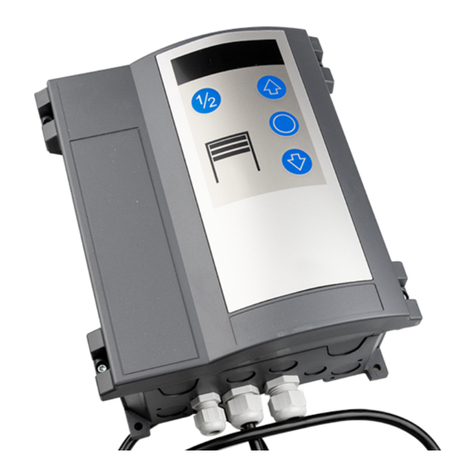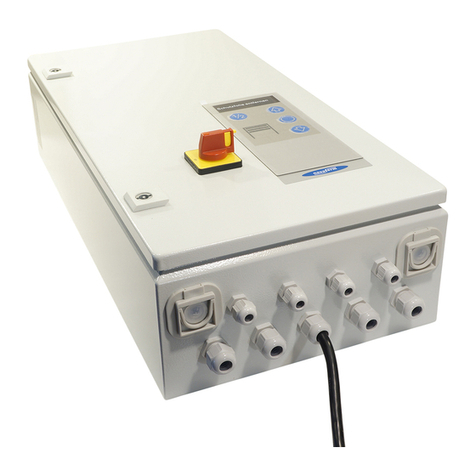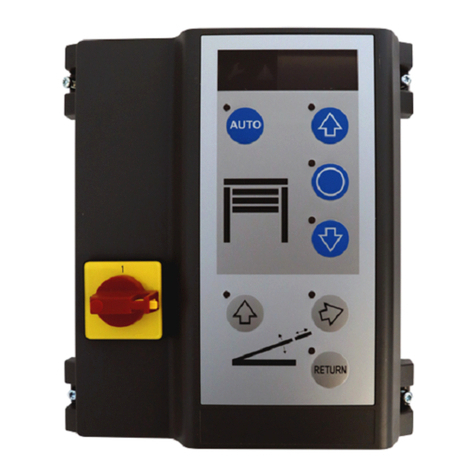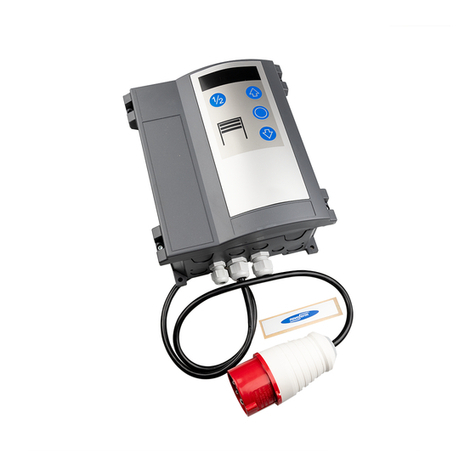
Bei Verwendung von 6.65DU weicht die
Funktion ab. Hierzu bitte denAbschnitt
“Funktion DU”berücksichtigen.
!
Öffnungskraftbegrenzung
Kraftmessfahrt
0
1
Funk Handsender einlernen
Auswahl Steuerungstyp
Startimpuls
(Menü 48)
Die Öffnungsfahrten werden mit der vorherigen Fahrt
verglichen. Bei Überschreitung mit dem eingestellten
Wert stoppt das Tor und F33 erscheint.
Das Tor kann anschließend nur im Totmann-
betrieb zugefahren werden. Ursache der
Kraftüberschreitung beseitigen und danach das
Tor auf und zufahren.
Motor 9.24/5.24: Eingabewert = U x Gewicht / 20Kg
Motor 9.20: Eingabewert = U x Gewicht / 16Kg
Motor 9.15: Eingabewert = U x Gewicht / 15Kg
Die Ergebnisse sind nur annäherungsweise zu
betrachten. Zur genaueren Bestimmung ist eine
Kraftmessfahrt durchzuführen.
Bei Verwendung von 6.65DU weicht die
Funktion ab. Hierzu bitte denAbschnitt
“Funktion DU”berücksichtigen.
zur Bestimmung der Abschaltschwelle.
Nach Eingabe des Wertes 99 im Menü 48 führt die
Steuerung eine Kraftmessfahrt durch:
1. Ein Prüfgewicht (empfohlen ca. 20Kg) am Tor
befestigen und Tor komplett auf und zufahren.
2.Anschließend erscheint im Menü 48 der Wert
und wird alsAbschaltwert übernommen. Der
Wert kann geändert werden (doppelter Wert
gleich doppelte Kraft).
3. Prüfgewicht wieder entfernen und Tor wieder auf
und zufahren.
51)
Eingang J1.3 wurden für Inpulsgabe ZU
Eingang J1.4 für Impulsgabe AUF
verwendet.
Das Tor muss von dem Ort der
Bedienung aus einsehbar sein.
Der Eingänge werden für Impulsgabe
Auf-Halt-Zu verwendet. J.1.3 für ½ Toröffnung
J1.4 für die volle Toröffnung.
Bitte beachten Sie, dass jeder Handsender für sich
eingelernt werden muss. Sie haben die Möglichkeit
30 Funkcodes einzulernen. Folgende Funktionen
sind einlernbar:
KeeLoq, 12 Bit Multibit. Der erste Code bestimmt den
Typ.
(Menü 59)
In Menü 59 werden verschiedene Steuerungstypen
ausgewählt. Entsprechende Einstellungen sind den
Zusatzblättern zu entnehmen.
(Menü 60)
Gehen sie ins Menü und betätigen Sie die Taste des
Handsenders für die Startfunktion. Sobald der Code
eingelernt ist blinkt die P
!
!
Einschaltdauer
RWA-Funktion (Rauch-Wärme-Abzug)
externe Befehlsgeräte / Impulsgeber
Lichtfunktion
(Menü 49)
Die eingestellte Einschaltdauer verhindert die
Überhitzung des Antriebsmotors und vermeidet
Schäden.
Bei Einsatz des Motors 5.24 mit Kunststoff-
getriebe muss die Einschaltdauer auf 1 (3~) oder
auf 2 (WS, 1~) eingestellt werden.
Im Menü 55 die entsprechende Torposition
einstellen. Brandmeldeanlage an J7 anschließen
und im Menü 50 Wert 7 einstellen.
(Menü
unktanzeige im Display 5
mal.
(Menü 62)
Gehen sie ins Menü und betätigen Sie die Taste des
!
Handsenders für die Lichtfunktion. Sobald der Code
eingelernt ist blinkt die Punktanzeige im Display 5
mal.
(Menü 63)
Um einen sicheren Betrieb der Überladebrücke zu
gewährleisten, muss die Erstinbetriebnahme von
sachkundigem Personal erfolgen.
- Stellen Sie den Hauptschalter ein
- Führen Sie einen Probelauf durch, indem Sie
alle Bedienfunktionen ausführen
Wenn alle Bedienfunktionen einwandfrei
durchgeführt werden können, ist die Überladebrücke
betriebsbereit.
Erstinbetriebnahme
Funkcodes löschen
DU Funktionen
Zum Löschen aller eingelernter Codes im Menü
ovale Taste für 5 Sekunden gedrückt halten.
(Hauptmenü 7)
Bei der Erstinbetriebnahme ist die Steuerung in
Menü 99 auf Werkseinstellungen zurückzusetzen.
Die Funktion “Öffnungskraftbegrenzung”im DU
kann im Menü 48 ausgewählt werden:
Wert = 0, Kraftbegrenzung aus
Wert = 1 - 99, Kraftbegrenzung ist aktiviert
Um den Antrieb gegen Überhitzung zu schützen,
muss die Einschaltdauer im Menü 49 auf 5
eingestellt werden.
!
Betriebsanleitung /
Funktionsbeschreibung
Betrieb der Überladebrücke
In diesem Kapitel beschreiben wir Ihnen den
kompletten Betrieb der Überladebrücke. Um ein
sicheres Arbeiten mit diesem Produkt zu
gewährleisten, ist es unbedingt erforderlich, dass Sie
die folgenden Sicherheits- und Gefahrenhinweise
befolgen.
Alle Personen, die die Überladebrücke bedienen,
müssen vorher eingewiesen worden sein. Der
Betreiber muss gewährleisten, dass alle Personen
die Einweisung verstanden haben.
Das Personal muss außerdem die Gebrauchs- und
Bedienungsanleitung aufmerksam gelesen und
verstanden haben. Das selbstständige Bedienen ist
nur unterwiesenen Personen und Personen mit
einem Mindestalter von 18 Jahren erlaubt.
1. Beachten Sie die Bewegungen der
Überladebrücke!
2. Während des Hebens und Senkens der
Überladebrücke dürfen sich keine Personen im
Bewegungsbereich der Überladebrücke
aufhalten.
3. Während des Verladens muss der Haupt-
schalter immer in Position I stehen.
Beim Verladebetrieb werden sonst die Höhen-
bewegungen des LKW von der Überladebrücke
nicht mitgemacht.
4. Stellen Sie in Notfällen den gelb-roten
Hauptschalter auf 0. Jede Bewegung der
Überladebrücke ist dann unterbrochen,
wenn Sie:
a) den Hauptschalter betätigen oder
b) die Stromversorgung unterbrechen oder
c) Not-Aus-Taster betätigen.
Der Verladevorgang muss abgebrochen werden
siehe Wiederanlaufsperre.
5. Vor der täglichen Inbetriebnahme muss die
Überladebrücke aus Sicherheitsgründen einer
Sichtprüfung unterzogen werden:
Wenn keine Beanstandungen vorliegen, können
Sie die Überladebrücke in Betrieb setzen.
Stellen Sie den Hauptschalter ein und betätigen
Sie kurz den Taster Heben.
Die Überladebrücke ist jetzt betriebsbereit.
Wenn Sie den Taster gedrückt halten, hebt sich
die Überladebrücke an.
Gleichzeitig schwenkt im oberen Arbeitsbereich der
Überladebrücke der Klappkeil aus.
Nach Loslassen des Tasters senkt sich die
Überladebrücke automatisch ab.
Nach Loslassen der Taste Heben , senkt sich die
Überladebrücke mit dem Auflager auf den LKW ab
und befindet sich in der Schwimmstellung. Die
Überladebrücke folgt den Höhenbewegungen des
LKWs.
Nach dem Wiedereinschalten des Hauptschalters
oder des Not-Aus-Tasters ist die Wiederanlauf-
sperre aktiv, die gelbe Warnanzeige blinkt im
Display.
Das Befahren der Überladebrücke ist in
diesem Fall verboten.
Wenn der Verladevorgang beendet ist, können Sie
durch Betätigen der Taste RETURN die
Überladebrücke zurück in die Ruhelage fahren.
Die Überladebrücke hebt an und senkt sich
anschließend ohne Tasterbewegung selbständig bis
auf Laderampenhöhe ab.
Heben
Schwimmstellung
Wiederanlaufsperre
Return / Überladebrücke in Ruhelage
Autotaster
(optional)
Beleuchtung und / oder Vorwarnlicht (optional)
Ladeleuchte (optional)
Sicherheitsradkeil (optional)
Funktion Schlüsselschalter (optional)
0
1
2
3
4
5
Durch kurzes Antippen der Taste AUTO fährt die
Überladebrücke automatisch in die Ruhestellung
zurück und das Tor schließt anschließend ohne
weiterer Tasterbetätigung selbstständig in die
Zuposition (nur möglich in ImpulsbetriebAuf / Zu).
Die Steuerung verfügt über 2 Relaisausgänge mit
denen Verladeleuchte und / oder Rot-Grün-Ampel
geschaltet werden kann (Menü 45 und 46).
Wenn das Tor die Offenstellung erreicht, schaltet die
Ladeleuchte ein. Sobald das Tor wieder die
Offenposition verlässt, schaltet die Ladeleuchte aus.
Nur wenn der Radkeil hinter dem LKW-Reifen
positioniert ist, kann die Überladebrücke Heben und
Ausfahren.
Die Steuerung besitzt einen Eingang für einen
Schlüsselschalter. Sie haben damit die Möglichkeit,
folgende Funktionen (Menü 50) zu aktivieren:
Impulsgeber mit SchaltfolgeAuf-Halt-Zu.
Bedienfeld der Steuerung wird gesperrt.
alle externen Bedienelemente werden gesperrt.
Bedienfeld der Steuerung und alle externen
Bedienelemente werden gesperrt.
Für 10 Sekunden sind Bedienfeld der Steuerung
und alle externen Bedienelemente aktiv.
Umschaltung der Betriebsart in Impuls Auf /
Totmann Zu
Selbstätige Rückkehr
Nach Wegfahren des LKWs startet die Überlade-
brücke selbstätig in die Ruhestellung und das Tor
fährt zu.
Diese Funktion ist nur möglich in Verbindung mit
entsprechenden Sensoren. Weiterhin muss ein
optisches und akustisch Signal muss installiert sein.
!
D


































